FLORIDA
History

History
Cities in FLORIDA
| Miami | Orlando |
Popular destinations USA
| Arizona | California | Florida |
| Hawaii | Utah |
History
First Florida residents
The first humans reached Florida about 12,000 years ago. They were attracted by the varied landscape with many (edible) plants and animals. Most of the animals still found in Florida still existed then, supplemented by extinct animals such as saber-toothed tiger, mastodon, giant armadillo and camel. The coastline along the Atlantic Ocean and the Gulf of Mexico was very different from the current coastline. The sea level was much lower than now and the peninsula was therefore twice as big.
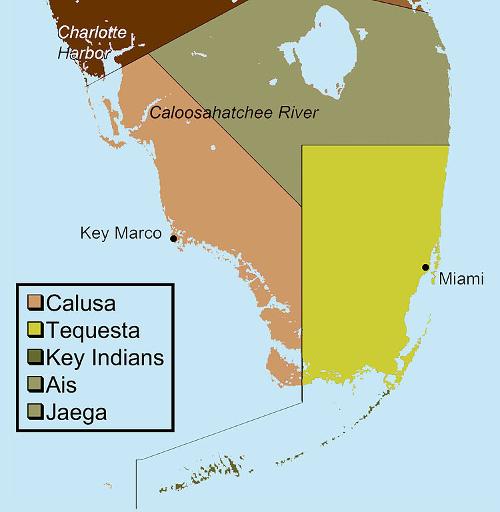 Originally residents in the Everglades, FloridaPhoto: Public domain
Originally residents in the Everglades, FloridaPhoto: Public domain
The then residents of Florida were hunters and gatherers, who mainly lived by hunting small (mammals) animals and collecting plants, nuts and crustaceans. The large mammals that were actually present were probably not hunted much. These first Floridians settled in areas where there was a constant supply of fresh water, suitable stones for making tools, and wood for making fire. Over a period of centuries, these humble indigenous people evolved into complex cultures that developed increasingly better agricultural methods, entered trade routes with the southeastern United States, and improved social organization resulted in the construction of large walled temples and village complexes.
European Explorers and Florida Colonization
Written resources on native Florida life have only been available since the discovery of Florida in 1513 by the Spanish explorer and adventurer Juan Ponce de León (ca. April 8, 1460-July 1521). Sometime between April 2 and 8, 1513, Ponce de León entered the northeast coast of Florida, possibly near present-day St. Augustine.
He named the area 'La Florida', after the Spanish Easter festival 'Pascua florida' (flower party). It is not entirely certain that Ponce de León was the first European to set foot on Floridian territory, but hard evidence to the contrary is lacking so far.
Another trip of Ponce de León, in 1521, ended on the southwestern coast of the peninsula. The ship was carrying a crew of about 200 people and fifty horses, but its colonization attempt was soon unsuccessful due to attacks from the native population. Yet Florida remained a favorite destination for explorers, missionaries and fortune seekers.
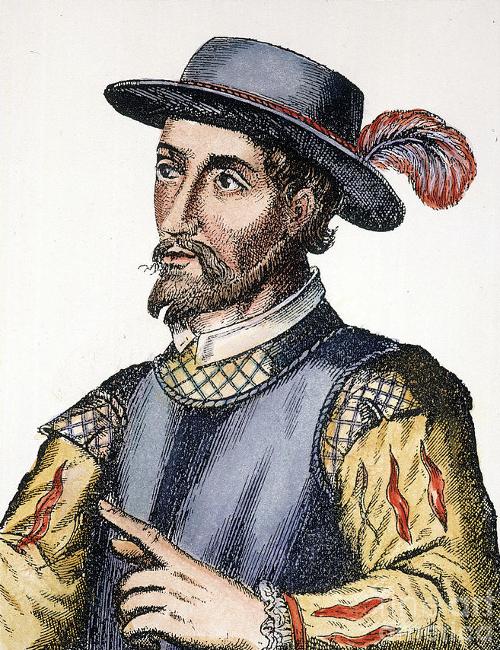 Juan Ponce de León, discoverer of FloridaPhoto: Unknown in the public domain
Juan Ponce de León, discoverer of FloridaPhoto: Unknown in the public domain
In 1539, the Spanish explorer Hernando de Soto (ca. 1497-1542) started an expedition in search of gold and silver. For four years he traveled across Florida and part of the southwestern United States (Georgia, Alabama and most likely Arkansas) in search of hidden Native American treasures. De Soto and his men camped in northern Florida for about five months near the current capital of Florida, Tallahassee. De Soto died on the banks of the Mississippi in 1542; he was the first European documented to have crossed that river; survivors of his expedition eventually reached Mexico.
Many treasures were ultimately not found in Florida by the Spanish conquistadors, who were much more successful in Cuba, Mexico, Central and South America. Heavily loaded ships passed Florida on their way to Europe, but pirates and tornadoes regularly caused heavy losses.
In 1559, Tristán de Luna y Arellano (1519-1573) made another attempt to colonize Florida on behalf of Spain. He founded a settlement near Pensacola Bay, but had to abandon his effort after two years. Another Spanish explorer who explored this area was Pánfilo de Narváez (ca. 1478-1528).
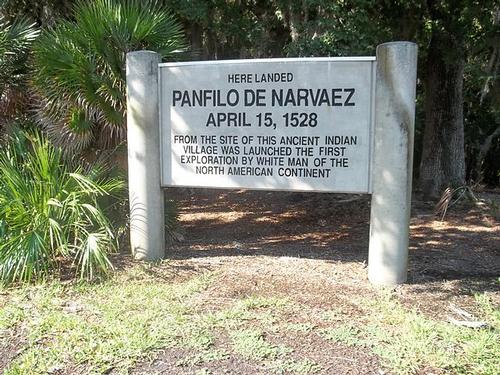 St. Petersburg, Florida, this is where Pánfilo de Narváez came ashorePhoto: Ebyabe CC 3.0 Unported no changes made
St. Petersburg, Florida, this is where Pánfilo de Narváez came ashorePhoto: Ebyabe CC 3.0 Unported no changes made
Meanwhile, other European nations also became interested in Florida, particularly the French. In 1562 this was the Protestant Jean Ribault (1520-1565), two years later René Goulaine de Laudonnère (c. 1529-1574) Fort Caroline at the mouth of the St. Johns River, near present-day Jacksonville.
First Spanish period
The activities of the French adventurers and explorers accelerated the Spanish response to colonize Florida. Pedro Menéndez de Avilés (1519-1574) rushed across the Atlantic from Spain to drive out the French and in 1565 founded the first permanent European settlement in what is now the United States, San Augustín (now: St. Augustine in Northeast Florida). He did manage to expel the French, only those who did not resist and who converted to the Catholic faith were allowed to stay. Fort Caroline was captured and renamed San Mateo.
Two years later, Dominique de Gourgues (1530-1593) took San Mateo again and all the Spanish soldiers were killed. However, the Spaniards were not discouraged by this and continued to establish fortresses and Roman Catholic missions. The missions were established among the Native American population and soon reached North Florida and even northern to present-day South Carolina.
At the end of the 16th century, Spain came into increasing conflict with the English, who were of course also very interested. in the treasures of America. On July 7, 1586, the English captain Sir Francis Drake (ca.1540-1596) sacked St. Augustine and burned it to the ground.
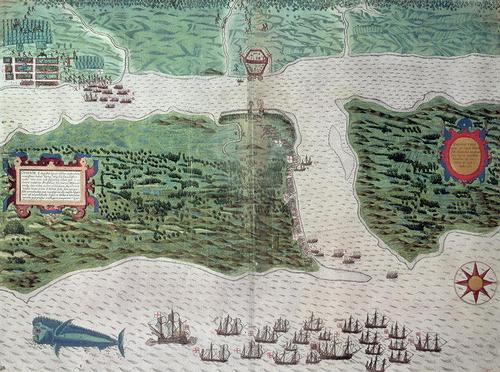 Drake's English fleet destroyed the Spanish colony of St. Augustine, FloridaPhoto: Public domain
Drake's English fleet destroyed the Spanish colony of St. Augustine, FloridaPhoto: Public domain
Even now the Spaniards did not let themselves be fooled and around 1600 they had full control over the current southeastern United States. However, it did not take long for the first English settlers to settle in America, including Jamestown (in present-day Virginia) in 1607, and Plymouth (in present-day Massachusetts) in 1620. Together with the English army, they drove the Spaniards south. to the south of Georgia. At the same time, French explorers were advancing east through the Mississippi Valley and up the Gulf of Mexico coast.
The North and South Carolina settlers, in particular, were very hostile to the Spanish. In 1702, along with the armies of Colonel James Moore (ca. 1650-1706) and the Creek Indians, they attacked Spanish Florida and destroyed the rebuilt St. Augustine. The accompanying fort, Castillo de San Marcos, was not captured at that time, but two years later all the missions between Tallahassee and St. Augustine had been destroyed and many Native Americans were killed or taken into slavery. The French continued to attack the western border of Spanish Florida and Pensacola was captured in 1719.
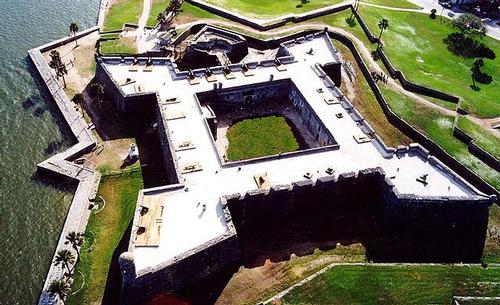 Castillo de San Marcos, FloridaPhoto: National Park service in the public domain
Castillo de San Marcos, FloridaPhoto: National Park service in the public domain
Spanish Florida came under further pressure after the southernmost state of Georgia, founded by the English in 1733. The people of Georgia attacked Florida in 1740, laying siege to Castillo San Marcos for nearly a month. Although this siege was not successful either, it gradually became clear that Spanish Florida was getting weaker.
British Florida
In 1763 the British gained control of Florida in exchange for Havana in Cuba, which the British had conquered from Spain during the Seven Years' War (1756-1763). The Spaniards withdrew almost completely from an extinct Florida; St. Augustine was now only a garrison town of no more than 500 houses, and Pensacola was also a small military town.
But the British had big plans for Florida. First, Florida was divided into East Florida, with St. Augustine as the capital, and West Florida, with Pensacola as the capital. British researchers mapped the landscape and coastline and linked up with a group of Indians entering Florida from the north, the so-called Seminoles. Furthermore, the British tried to persuade settlers to move to Florida by offering their land. Had enough time had been given, Florida would likely have become a thriving colony, but British rule lasted only twenty years.
The two Floridas remained loyal to the British Empire throughout the American War of Independence (1776-1783). Spain, indirectly a vassal of the French, conquered Pensacola from the British in 1781. In 1784 the Spanish regained possession of Florida, an outgrowth of the Peace of Paris (also known as Versailles), the peace treaty that ended. the American Revolutionary War.
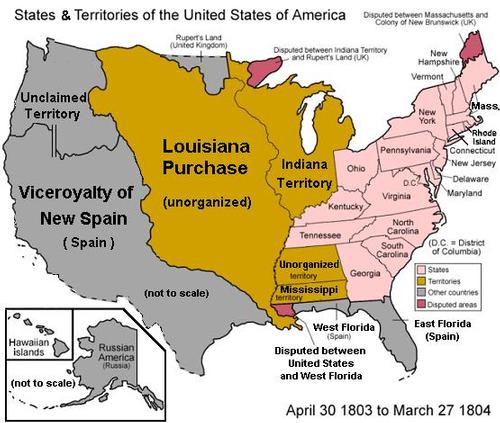 United States in 1803/1804Photo: Golbez CC 2.5 no changes made
United States in 1803/1804Photo: Golbez CC 2.5 no changes made
Second Spanish period
After the British cleared the field, Spanish and American colonists flocked in en masse, attracted by the attractive settlement conditions. Many slaves from the United States also fled to Florida, where their bosses could no longer reach them. This made the two Floridas not Spanish, but more American. Finally, after several US military expeditions, Spain transferred Florida to the United States in 1821 under the terms of the Adams-Onís Treaty. On one of the expeditions, in 1818, General and later President Andrew Jackson (1767-1845) invaded Florida. Jackson's battles with the Native American population, which had many problems with Florida's white population, is known as the First Seminole War (1835-1842).
As a part of the United States, Florida became attractive to people from the southern plantation states of Virginia, North and South Carolina, and Georgia. Soon, the two Floridas were considered one entity with Tallahassee as its capital, chosen in 1824 because it was halfway between the existing administrative centers of St. Augustine and Pensacola. The continued influx of "Americans" forced the Florida administration to drive the Indians, especially of the Creek, Seminole, and Miccosukee tribes, from their lands to make way for the settlers. In addition, fled slaves from the north often had shelter among the Indians. A famous Seminole chief and war leader, Osceola, commanded a lot of respect from his opponents, but eventually also had to bow his head. Under President Andrew Jackson, the Seminole wars cost $ 20 million and the lives of many soldiers, Indians and civilians. And eventually the 'removal' of the Seminoles failed, some left 'voluntarily', some were captured and driven west under military guidance, still others fled into the Everglades and avoided all contact with the whites.
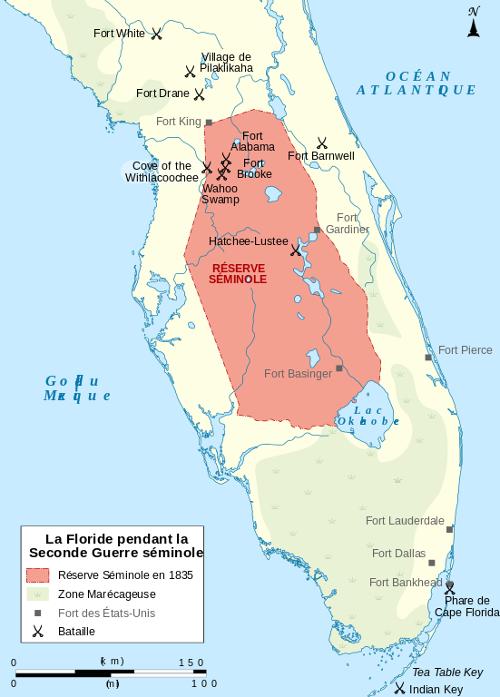 Florida at the time of the Second Seminole WarPhoto: Sémhur CC 4.0 International no changes made
Florida at the time of the Second Seminole WarPhoto: Sémhur CC 4.0 International no changes made
Around 1840 the Floridians concentrated on developing the territory, the main economic activity was agriculture, and obtaining 'state' status. The population at that time numbered about 55,000 people, of which about half were black slaves. Florida at the time was unofficially divided into three areas: East Florida from the Atlantic Ocean to the Suwannee River; Central Florida between the Suwannee and Apalachicola Rivers; and West Florida from the Apalachicola to the Perdido River. South Florida, south of present-day Gainesville, was scarcely populated by whites. The acreage of plantations was concentrated in Central Florida and the owners set the political tone in Florida until after the Civil War.
Florida, the 27th state in the United States
On March 3, 1845, Florida became the 27th state in the United States and William Dunn Moseley (1795-1863) was elected as the first governor of the new state. David Levy Yulee, one of the greatest advocates for joining the United States, became a senator in the national parliament.
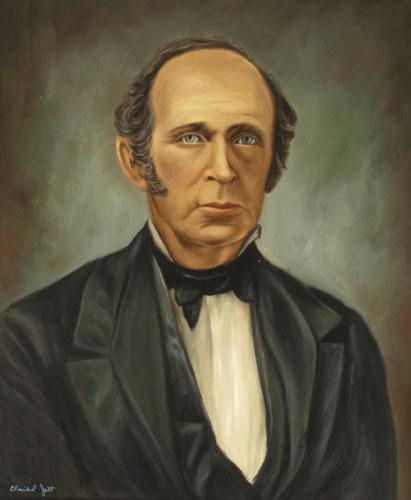 William Dunn Moseley, First Florida GovernorPhoto: State of Florida in the public domain
William Dunn Moseley, First Florida GovernorPhoto: State of Florida in the public domain
By 1850, the population had grown to about 87,500 people, including about 39,000 slaves and about 1,000 free blacks.
Soon the issue of slavery began to affect (political) life in Florida. Most Florida voters, white men 21 or older, were not against slavery and so were concerned about the anti-slavery sentiment in the northern United States and about the new Republican during the 1950s. Party that joined. It was not surprising, then, that hardly anyone in Florida voted for the Republican candidate from Illinois, Abraham Lincoln, who did win.
The Floridians did not like Lincoln at all, and a special convention was called shortly after his election , which issued a decree allowing Florida to secede from the Union on January 10. Within weeks, Florida joined the Confederate States of America, known as Confederation for short, a confederation of southern states. This secession led to the American Civil War (1861-1865), which was lost by the Confederacy and after which the southern states were placed under political receivership through the Reconstruction.
American Civil War and Reconstruction
With no major battles fought in Floridian territory, Florida was not as affected by the Civil War as many other southern states. Union troops occupied many coastal towns and fortresses, the interior of Florida was in the hands of the Confederacy. Florida provided approximately 15,000 troops and much food and supplies to the Confederacy, but approximately 2,000 Floridians, both African-American and White, joined the Union military. Confederacy and foreign merchant ships slipped through the coastal blockade of the Union and managed to supply the troops. Tallahassee was the only southern capital east of the Mississippi that was not occupied, but the South was eventually conquered and federal troops occupied Tallahassee on May 10, 1865.
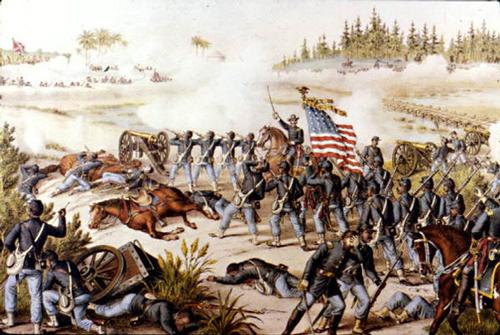 Battle of Olustee, Florida (1864)Photo: Public domain
Battle of Olustee, Florida (1864)Photo: Public domain
Before the Civil War, Florida was on its way to becoming one of the southern cotton states. After the civil war, that course changed. The ports of Jacksonville and Pensacola flourished as a result of the demand for timber and timber products to rebuild the many destroyed cities. The slaves have now been declared free and former plantation owners tried to hire their former slaves to work on the (cotton) plantations.
From 1868, a program was drawn up by the federal government for Florida and the other southern ones. states, the so-called 'Reconstruction'. The Republicans tried to bring about major changes, particularly to improve the living conditions of African Americans.
At the time of the 1876 presidential election, Florida was still occupied by federal forces. The Florida Republican Parliament and the free African-Americans helped get Rutherford B. Hayes into the White House. Still, the Democrats managed to end Republican rule in Florida, resulting in the withdrawal of federal troops. Despite some heated political battles in the state parliament, African Americans had very little to say in the administration of the state of Florida.
Florida is developing
During the last quarter of the 19th century, the commercial agricultural sector, and in particular livestock farming, became increasingly important. Industrial activities such as the cigar industry have become established in the immigrant society of Florida. Major investors were interested in companies that extracted resources from water and land, such as sponges in Tarpon Springs and phosphate mines in the southwest of the state. The citrus industry grew rapidly, despite some freezing periods and economic problems. From 1855, these industrial developments accelerated the construction of many roads and railways through the so-called 'Internal Improvement Act'. Many railways were operated by Henry M. Flagler (1830-1913) and Henry B. Plant (1819-1899), who built large hotels near the railways.
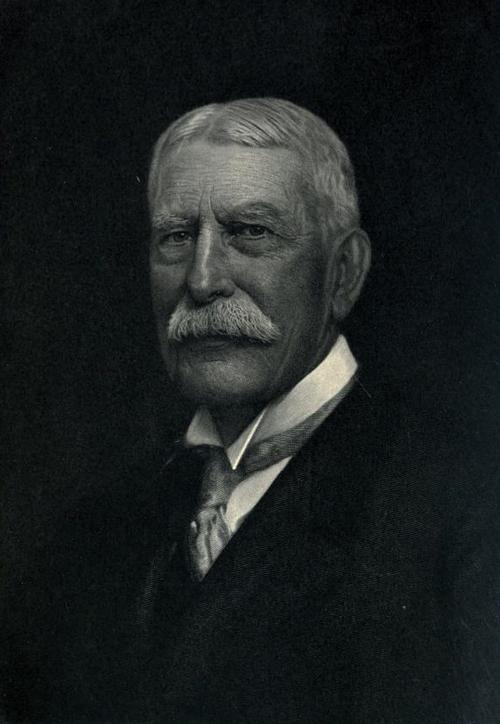 Portrait of Henry Morrisson Flagler, FloridaPhoto: JJ Cade, in the public domain
Portrait of Henry Morrisson Flagler, FloridaPhoto: JJ Cade, in the public domain
From the 1970s onwards, the tourism industry started from the northern United States, including steamboat tours over the rivers were very popular. The Internal Improvement Act also made the marshy and swampy landscape of southern Florida suitable for agricultural use by drainage. All these developments greatly affected the economy of late 19th-century Florida. The citrus industry, in particular, benefited fully from the draining of South Florida and exports to the northern United States.
In 1898, Florida was the focus of attention at the start of the Spanish-American War. The port of Tampa was used by American troops as a starting point for the battlefield in Cuba. Many Floridians supported the Cubans in their struggle for independence from Spain.
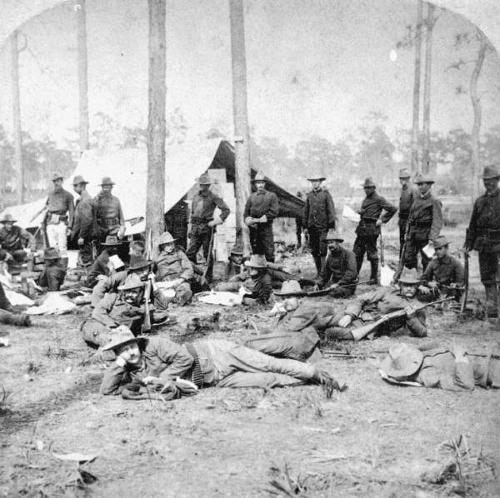 So-called Rough Riders in Florida during the Spanish-American WarPhoto: Public domain
So-called Rough Riders in Florida during the Spanish-American WarPhoto: Public domain
At the turn of the century, the population and income of the population grew rapidly and the possibilities of the Sunshine State seemed endless. Towards the end of World War I, many land developers saw a virtual gold mine emerge in Florida, enhanced by the emergence of the automobile, allowing more people to spend their Florida vacation. Land in Florida became increasingly expensive as a result of these developments.
The economic bubble was inevitably created by Florida's rapid development burst in 1926. Bankers and investors suddenly lost faith in the 'papers' millionaires. In addition, the economy suffered from several hurricanes in 1926 and also in 1928. By the time the Great Depression hit the United States and the rest of the world badly in 1929, Florida was already somewhat accustomed to the economic downturn. In 1929 Florida was again hit by the imported Mediterranean fruit fly. Despite some protective measures by the government, citrus fruit production declined by about 60%.
In administrative and political terms, more and more groups of the population gained influence. Women were given the right to vote in 1920, in 1937 poor African Americans and white Floridians were given more chances to vote because the so-called 'tax tax' was abolished. In 1944 everyone finally got unlimited voting rights.
Florida after WWII
The Second World War brought an economic revival in Florida. Due to its mild year-round climate, the state was used as an ideal training ground for American and Allied soldiers, sailors and airmen. The construction of highways and airfields was accelerated, providing Florida with an up-to-date and modern transportation system after the war, which was used by its own citizens and industry, as well as by a rapidly increasing flow of visitors from home and abroad. The growth of the population also took spectacular forms due to both domestic immigration and migrants from Cuba and Haiti in particular. People from the diverse populations have fought to make Florida a state where all residents would have legal equal rights. Public education has undergone major changes since the 1950s. African American citizens, backed by 33rd Florida Governor LeRoy Collins (Governor from 1/4/1955 to 1/3/1961), and other whites, fought to end discrimination in education and other social institutions.
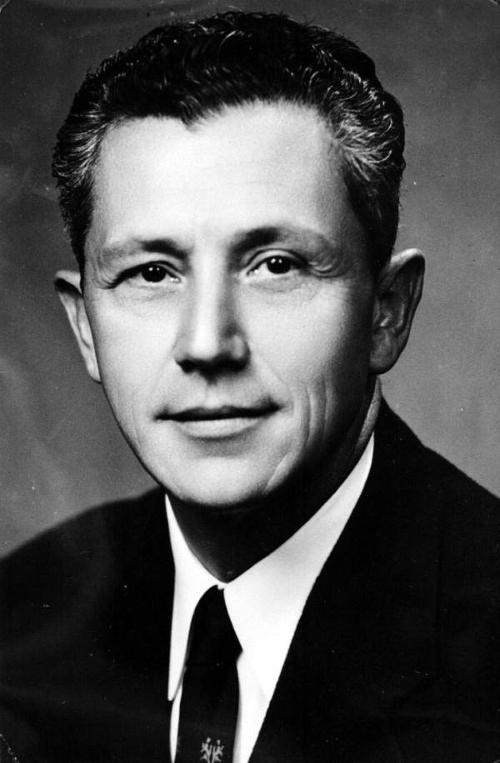 LeRoy Collins (1909- 1991), 33rd Governor of FloridaPhoto: Public domain
LeRoy Collins (1909- 1991), 33rd Governor of FloridaPhoto: Public domain
Since World War II, Florida's economy has become much more diverse. In addition to the well-known sectors such as tourism, livestock, citrus and phosphate, a series of new industries were added, including electronics, plastics, construction, housing and international banks settled in booming Florida. Many important American multinationals relocated their headquarters to Florida.
Important to this were an excellent highway system, the construction of important international airports, the establishment of many excellent universities and the establishment of high-tech industries. The best-known example of this is the space program of the United States, which was developed and implemented from Cape Canaveral. The citrus industry and tourism remain important branches of the economy. Major attractions like the theme parks near Orlando continue to attract millions of visitors from the United States and around the world year after year in the 21st century.
In August 1992, Hurricane Andrew caused 26.5 billion dollar damage. 65 people were killed and 177,000 people were left homeless.
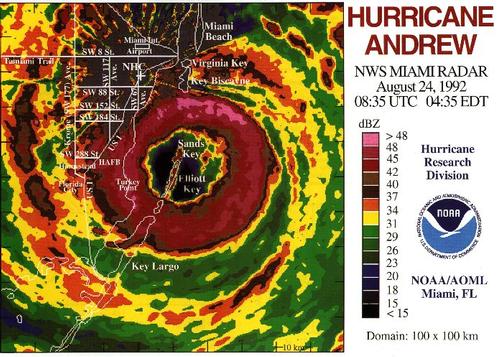 Hurricane Andrew hits Florida in 1992Photo: US National Weather Servicein the public domain
Hurricane Andrew hits Florida in 1992Photo: US National Weather Servicein the public domain
In September 2017, Florida was hit by Hurricane Irma, a fourth-category hurricane that previously left a trail of death. and caused destruction in the Caribbean.
Before the hurricane made landfall, 6.5 million Florida residents fled north. On return, the damage was massive and 5.8 million households were without electricity.
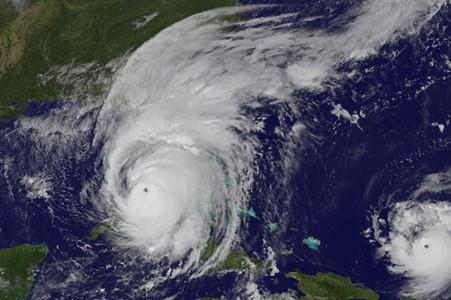 Hurricane Irma makes landfall in FloridaPhoto: MODIS image captured by NASA ' s Aqua satellite in the public domain
Hurricane Irma makes landfall in FloridaPhoto: MODIS image captured by NASA ' s Aqua satellite in the public domain
The Florida Keys, an archipelago south of Florida, were the hardest hit; 25% of the houses were destroyed and 60% damaged. In Florida, six were killed and many injured.
See also the history of USA on TheWorldOfInfo.
Sources
Bailey, Ruth / Florida
Van Reemst, Uitgeverij Unieboek, Het Spectrum BV
BBC - Country Profiles
CIA - World Factbook
Elmar Landeninformatie
Hull, Sarah / The rough guide to Florida
Rough Guides
Karlin, Adam / Discover Florida
Lonely Planet
Karlin, Adam / Florida
Lonely Planet
McKechnie, Gary / Florida : de reisgids voor een actieve & culturele vakantie
Kosmos Uitgevers
Pinck, Axel / Florida
ANWB
Sanders, Bert / Florida : reizen met insider tips
Van Reemst
Skolnick, Adam / Florida & the South's best trips : 28 amazing road trips
Lonely Planet
Wikipedia
Last updated November 2025Copyright: Team The World of Info